Chinook salmon is also known as king salmon. It is the largest species of salmon in the Pacific Ocean, with a maximum length of 58 inches and a record weight of 126 pounds. Freshwater rivers and streams are the sites of the intriguing spawning process for Chinook salmon.
Once at the spawning grounds, females lay thousands of eggs, which are subsequently fertilized by males, in gravel nests known as redds. Chinook salmon typically live for 3 to 7 years.
Life History of Chinook Salmon
As anadromous fish, chinook salmon spend their first year in main-channel river basins after hatching in freshwater. After that, they change into smolts and move to saltwater estuaries, where they spend one to five years feeding and developing. To spawn, they migrate back to freshwater, where they all perish. Their size at maturity is determined by their sexual maturity age, which varies from 2 to 7 years. Females are usually older than males, and males often outweigh females in most spawning runs.
Chinook may travel more than 2,000 river miles on their spawning migrations, and they do not feed during this time. In gravel nests, females lay up from 3,000 to 14,000 eggs. After hatching, the eggs become alevins, which develop into fry and finally smolts. In freshwater, juveniles eat plankton and insects. A mature 3-year-old will probably weigh less than 4 pounds, while a mature 7-year-old may exceed 50 pounds.
Scientific Name
The scientific name of Chinook salmon is Oncorhynchus tshawytscha, and other vernacular names are Blackmouth, Tyee and King Salmon.
Range
Chinook salmon are mostly found in the North Pacific Ocean and inhabit the Monterey Bay region of California and the Chukchi Sea region of Alaska in North America.
Appearance

Chinook salmon are silver in appearance, with a dark blue or greenish back and a smooth, streamlined body. Small black dots on their upper torso, tail, and dorsal fin help to identify them.
Habitat
Chinook salmon are marine animals that spawn in freshwater streams and estuaries before returning to their original streams.
Diet
At different phases of their lives, Chinook salmon eat different kinds of prey: as juveniles in freshwater, they eat plankton and insects; as adults in the ocean, they eat squid, herring, sandlance, and crustaceans.
Conservation
Preservation is hampered by pollution, overfishing, climate change, and habitat loss. Restoration of their habitat, restrictions on fishing, and projects to improve water quality and enhance river accessibility are all part of the protection strategy.
Fun Facts
Size Records: Grow up to 126 pounds, and are the largest species of the Pacific salmon.
Long Lifespan: Chinook salmon have a life span of three to seven years, depending on the population.
Color Change: During spawning, males change from gray to reddish-brown and develop a characteristic hooked jaw or kype.


I didn’t know that Chinook salmon could weigh up to 140 pounds! That’s astonishing.
The flavor of Chinook salmon is incredible! Perfect for my favorite recipes.
Chinook salmon fishing is a thrilling experience! Can’t wait for the next season.